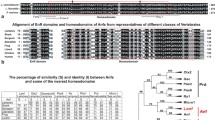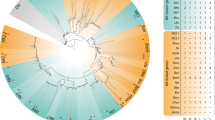Abstract
We have identified two Tbx1/10-related genes, LjTbx1/10A and LjTbx1/10B, from the Japanese river lamprey Lethenteron japonicum. We used in situ hybridization to characterize their expression pattern during embryonic development. LjTbx1/10A and LjTbx1/10B shared common expression in the pharyngeal arches and otic vesicle, although their levels and timing of expression differed markedly. LjTbx1/10A was highly expressed in the mesodermal core of pharyngeal arches and the adjacent endoderm throughout pharyngeal arch development, whereas LjTbx1/10B expression was only transiently upregulated in forming pharyngeal pouches. LjTbx1/10A transcripts first appeared at stage 25 in otic vesicles, whereas LjTbx1/10B transcripts could already be detected in the developing otic placode at stage 20. These results suggest that lamprey LjTbx1/10A and LjTbx1/10B may play distinct roles in the patterning and development of the pharyngeal apparatus. It appears that lamprey Tbx1/10 genes have undergone subfunctionalization independent from gnathostomes, with regard to both regulation and function.



Similar content being viewed by others
References
Arnold JS, Werling U, Braunstein EM, Liao J, Nowotschin S, Edelmann W, Hebert JM, Morrow BE (2006) Inactivation of Tbx1 in the pharyngeal endoderm results in 22q11DS malformations. Development 133:977–987
Ataliotis P, Ivins S, Mohun TJ, Scambler PJ (2005) XTbx1 is a transcriptional activator involved in head and pharyngeal arch development in Xenopus laevis. Dev Dyn 232:979–991
Bollag RJ, Siegfried Z, Cebra-Thomas JA, Garvey N, Davison EM, Silver LM (1994) An ancient family of embryonically expressed mouse genes sharing a conserved protein motif with the T locus. Nat Genet 7:383–389
Bush JO, Maltby KM, Cho ES, Jiang R (2003) The T-box gene Tbx10 exhibits a uniquely restricted expression pattern during mouse embryogenesis. Gene Expr Patterns 3:533–538
Bush JO, Lan Y, Jiang R (2004) The cleft lip and palate defects in Dancer mutant mice result from gain of function of the Tbx10 gene. Proc Natl Acad Sci USA 101:7022–7027
Chapman DL, Garvey N, Hancock S, Alexiou M, Agulnik SI, Gibson-Brown JJ, Cebra-Thomas J, Bollag RJ, Silver LM, Papaioannou VE (1996) Expression of the T-box family genes, Tbx1-Tbx5, during early mouse development. Dev Dyn 206:379–390
Chieffo C, Garvey N, Gong W, Roe B, Zhang G, Silver L, Emanuel BS, Budarf ML (1997) Isolation and characterization of a gene from the DiGeorge chromosomal region homologous to the mouse Tbx1 gene. Genomics 43:267–277
Garg V, Yamagishi C, Hu T, Kathiriya IS, Yamagishi H, Srivastava D (2001) Tbx1, a DiGeorge syndrome candidate gene, is regulated by sonic hedgehog during pharyngeal arch development. Dev Biol 235:62–73
Hammond KL, Whitfield TT (2006) The developing lamprey ear closely resembles the zebrafish otic vesicle: otx1 expression can account for all major patterning differences. Development 133:1347–1357
Jerome LA, Papaioannou VE (2001) DiGeorge syndrome phenotype in mice mutant for the T-box gene, Tbx1. Nat Genet 27:286–291
Katoh K, Misawa K, Kuma K, Miyata T (2002) MAFFT: a novel method for rapid multiple sequence alignment based on fast Fourier transform. Nucleic Acids Res 30:3059–3066
Kochilas LK, Potluri V, Gitler A, Balasubramanian K, Chin AJ (2003) Cloning and characterization of zebrafish tbx1. Gene Expr Patterns 3:645–651
Kuraku S, Kuratani S (2006) Time scale for cyclostome evolution inferred with a phylogenetic diagnosis of hagfish and lamprey cDNA sequences. Zool Sci 23:1053–1064
Law DJ, Garvey N, Agulnik SI, Perlroth V, Hahn OM, Rhinehart RE, Gebuhr TC, Silver LM (1998) TBX10, a member of the Tbx1-subfamily of conserved developmental genes, is located at human chromosome 11q13 and proximal mouse chromosome 19. Mamm Genome 9:397–399
Mahadevan NR, Horton AC, Gibson-Brown JJ (2004) Developmental expression of the amphioxus Tbx1/10 gene illuminates the evolution of vertebrate branchial arches and sclerotome. Dev Genes Evol 214:559–566
Minguillon C, Logan M (2003) The comparative genomics of T-box genes. Brief Funct Genomic Proteomic 2:224–233
Murakami Y, Ogasawara M, Sugahara F, Hirano S, Satoh N, Kuratani S (2001) Identification and expression of the lamprey Pax6gene: evolutionary origin of the segmented brain of vertebrates. Development 128:3521–3531
Papaioannou VE (2001) T-box genes in development: from hydra to humans. Int Rev Cytol 207:1–70
Piotrowski T, Ahn DG, Schilling TF, Nair S, Ruvinsky I, Geisler R, Rauch GJ, Haffter P, Zon LI, Zhou Y, Foott H, Dawid IB, Ho RK (2003) The zebrafish van gogh mutation disrupts tbx1, which is involved in the DiGeorge deletion syndrome in humans. Development 130:5043–5052
Raft S, Nowotschin S, Liao J, Morrow BE (2004) Suppression of neural fate and control of inner ear morphogenesis by Tbx1. Development 131:1801–1812
Ryan AK, Goodship JA, Wilson DI, Philip N, Levy A, Seidel H, Schuffenhauer S, Oechsler H, Belohradsky B, Prieur M, Aurias A, Raymond FL, Clayton-Smith J, Hatchwell E, McKeown C, Beemer FA, Dallapiccola B, Novelli G, Hurst JA, Ignatius J, Green AJ, Winter RM, Brueton L, Brondum-Nielsen K, Scambler PJ (1997) Spectrum of clinical features associated with interstitial chromosome 22q11 deletions: a European collaborative study. J Med Genet 34:798–804
Saitou N, Nei M (1987) The neighbor-joining method: a new method for reconstructing phylogenetic trees. Mol Evol Biol 4:406–425
Sauka-Spengler T, Le Mentec C, Lepage M, Mazan S (2002) Embryonic expression of Tbx1, a DiGeorge syndrome candidate gene, in the lamprey Lampetra fluviatilis. Gene Expr Patterns 2:99–103
Showell C, Christine KS, Mandel EM, Conlon FL (2006) Developmental expression patterns of Tbx1, Tbx2, Tbx5, and Tbx20 in Xenopus tropicalis. Dev Dyn 235:1623–1630
Simon HG, Kittappa R, Khan PA, Tsilfidis C, Liversage RA, Oppenheimer S (1997) A novel family of T-box genes in urodele amphibian limb development and regeneration: candidate genes involved in vertebrate forelimb/hindlimb patterning. Development 124:1355–1366
Steinberg M (1957) A nonnutrient culture medium for amphibian embryonic tissues. Carnegie Inst Washington Year Book 56:347–348
Streit A (2001) Origin of the vertebrate inner ear: evolution and induction of the otic placode. J Anat 199:99–103
Tahara Y (1988) Normal stages of development in the lamprey, Lampetra reissneri (Dybowski). Zool Sci 5:109–118
Takatori N, Hotta K, Mochizuki Y, Satoh G, Mitani Y, Satoh N, Satou Y, Takahashi H (2004) T-box genes in the ascidian Ciona intestinalis: characterization of cDNAs and spatial expression. Dev Dyn 230:743–753
Xu H, Cerrato F, Baldini A (2005) Timed mutation and cell-fate mapping reveal reiterated roles of Tbx1 during embryogenesis, and a crucial function during segmentation of the pharyngeal system via regulation of endoderm expansion. Development 132:4387–4395
Xu H, Viola A, Zhang Z, Gerken CP, Lindsay-Illingworth EA, Baldini A (2007) Tbx1 regulates population, proliferation and cell fate determination of otic epithelial cells. Dev Biol 302:670–682
Acknowledgments
We thank Ebetsu fishery cooperative for providing adult male and female lampreys. E. T. was supported by the JSPS Postdoctoral Fellowship for Foreign Researchers (PE05004). This work was partly supported by a Grant-in-Aid for Young Scientists Category A from the Ministry of Education, Science, Sports and Culture of Japan, a Tokyo Tech Award for Challenging Research and a research grant to M. T. from the Hayashi Memorial Foundation of Female Natural Scientists.
Author information
Authors and Affiliations
Corresponding author
Additional information
Communicated by M. Hammerschmidt
Tiecke and Matsuura contributed equally to this work.
Rights and permissions
About this article
Cite this article
Tiecke, E., Matsuura, M., Kokubo, N. et al. Identification and developmental expression of two Tbx1/10-related genes in the agnathan Lethenteron japonicum . Dev Genes Evol 217, 691–697 (2007). https://doi.org/10.1007/s00427-007-0181-0
Received:
Accepted:
Published:
Issue Date:
DOI: https://doi.org/10.1007/s00427-007-0181-0




